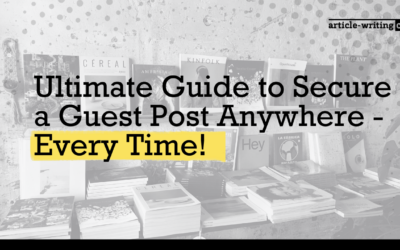The biggest mistake that most small businesses and startups make when they are trying to get press coverage is believing that their mere existence is a story within itself. “My name is Jim and I have a Donut Shop” is not a PR story and unless you run the first startup on Mars, then no one is really going to care that you opened up a new office.
Readers are only interested in what your business does after you’ve captured their interest. Alex Wilhelm from TechCrunch has a little bit of advice for people trying to get journalists to cover their work —> “When you’re f***ing boring…that’s the worst thing.”
Content like product descriptions or practical information about your business doesn’t have that viral potential because it’s just not that interesting. Before pitching your story to a journalist, give it the ‘who cares?’ test. Test your pitch with a few friends, your grandma, or the barista at the coffee shop and gauge their reaction. Be warned – do not confuse polite nodding with genuine interest. If no one is into your content, don’t waste your time pursuing it until you have a more compelling angle.
Tell Your Story The Right Way
The key to creating a compelling PR story for the media is to find the right angle. At its bare bones, your story may have the same framework no matter which way you tell it. Although that framework is a critical part of your story, it is how you choose to tell your story that matters the most.
Let’s take this joke for example —> “The Aristocrats”
This is a famous joke among comedians that has been told a countless amount of times in a countless amount of ways.
The joke is simple – it contains three parts:
- The Setup – A family visits a talent agent to pitch their act.
- The Delivery – The family performs their act for the talent agent.
- The Punchline – In response, the talent agent asks what the name of the act is, to which the family responds “The Aristocrats!”
If you look at the framework for this joke, there is nothing really funny about it at all. In fact, if you told this joke in its barest form, you would probably never get a laugh. Yet this is a joke with such infamy that a documentary was made entirely about the telling and re-telling of it by hundreds of different comedians.
This is essential for small business owners to realize. Even if it feels like your story is boring, there is a way to tell it so that it is exciting and appealing to the media and your audience. You need to find the boring old framework of your story and then tell it in an incredible way.
Wait One Second…
If you think you have your pitch all figured out, don’t go rushing into things head first. Even a great pitch can fall flat if the proper approach isn’t taken. Running around and shouting at everyone or at the wrong people about your story isn’t guaranteed to get you attention. In fact, it may just annoy some of the very people that you are trying to impress. Before you ruin your chance at getting some exposure, consider these common mistakes many startups make when pitching to journalists.
Do Your Research
If you want a journalist to cover your company or product, then you need to know who you’re approaching. Rather than just spamming every journalist you can think of with pitches about your product, use a little more strategy. Journalist Andrew Ross of the San Francisco Chronicle believes strongly in people educating themselves before they approach journalists with a pitch. “Do your homework. Know who we are and what we’re interested in!”
Set Reasonable Targets
Instead, start small. In his Huffington Post piece, Richard Lorenzen says that businesses should “use your valuable time to focus on pitching ideas to smaller outlets” because you’ll have a better chance of success than you would if you’re approaching the big ones directly. Public Relations specialist Melanie Downey reminds businesses that “larger media outlets often look to the smaller ones for story ideas.” Stories from local outlets often get picked up by ABC, MSNBC, Yahoo, and other bigger sources that have more clout when it comes to distributing viral content.

So What Makes A Great PR Story?
We can all probably name a great book (Ender’s Game, Orson Scott Card) or a movie that drove you (me) to tears (of fear) (Dennis the Menace, 1993), but naming a story that is perfect for a company’s PR campaign is a little tougher. Instead, let’s look at a few elements that make a great PR story.
Context
Your business doesn’t exist in a bubble, and it’s your job to create a context around why people should care. PR Hacker expert Ben Kaplan tells us that “just because your product serves a niche market that doesn’t mean your story idea has to be niche too.” He uses the example of an app that connected pets with new owners. The app hadn’t been successful in gaining users, so Kaplan’s team needed to put the app into a bigger context. They used the topic of dating and relationships to tie the app into a story about which dog breed would be most likely to get you a date. The story gained a ton of attention, simply by aligning itself with a larger and more meaningful context.
It’s Not Just About You
If you’re only thinking about yourself, you’ll never gain any traction with readers. Flip the mirror towards your customers. Give them insight into what they want and need for themselves. Emmy Award-winning reporter Kym McNicholas hit the nail on the head when she pointed out “He [Steve Jobs] discovered problems that you didn’t even know you had. It was never the product, it was always the story, it was always the customer.” Relating to and solving a customer’s problem will engage readers and pique their interest in a way that just talking about yourself simply can’t.
Provide Value
Your reader’s time is precious, so use their attention wisely. Give them something that will stick, like a practical solution that they can apply in their daily lives. Journalist Deborah Jian Lee says “…readers are more likely to share material that they find useful and makes them look good. Demonstrate the value of your content, and watch your numbers soar.” This is also one of the best ways to establish your expertise and build a relationship with your audience.
What Journalists Crave For Their Next Story
As a startup, you have a particular interest in getting a journalist to write about your business, but you should be aware that journalists probably don’t share that same interest. You need to convince them that you have a story that is worth sharing. You need to woo them with flowery words, take them to a special place, and make them love your pitch.
To make this easier, we’ve laid out a few things that journalists crave when they are seeking their next story.
Reader Interest
One of the first things that journalists consider is whether a story is relevant. Is this something that people are talking about? Something that they care about? As the American Press Institute points out “Though journalists may think, and in fact may know, that something is “news,” declaring it so doesn’t make it true to the news consumer. Relevancy should not be assumed.”
Personal Connection
Reporter Glenn Halbrooks points out that stories need to hit home for the readers in some way, and this often means finding a way to whittle a global news story down into something that’s meaningful in their lives. He writes “Even if you’re thousands of miles away from the action, you can localize the story to bring it closer to home.”
Layers
Journalist Jody Avirgan notes the importance of stories that have a depth that can be explored further. Pieces that have lots of potential for additional sources, or footnotes, which as Avirgan says are “Basically a sign that reads ‘rabbit hole entrance here.’”
Emotion
People respond to stories that strike an emotional chord. Journalist Jerrid Grimm explains that “Human narratives tend to be more interesting than facts and figures alone. Telling a personal narrative forms an emotional connection with the reporter, and with their readers.” Whether your business sells coffee makers or delivers food, finding a way to bring a human element to your story is critical.
So What’s Next?
Let’s assume that you have gotten inside your reader’s head, identified what they really want, and have figured out a way to deliver a great story in an authentic and appealing way. Now what?
A story doesn’t mean much if no one ever reads it. This means that before your story can make even the slightest impact, it needs to be shared and shared again. The best way to do this is by getting it on the right journalist’s desk, but this is a task easier said than done.
If you have a great story, this will help tremendously, but you will still need to be strategic and careful about how you get it out there. Resist the temptation to start spamming every journalist in your mailing list. Instead, take the time to think about where it belongs and find it a happy home.
For advice on how to get press for your startup, check out some of our other guides below, or give us a shout anytime.
We are here to help and we love to hear new stories!

Eli is an expert in PR, Outreach, and SEO writing. He’s worked in the industry for over a decade and excelled in providing clients with effective content marketing strategies that have had incredible success.




